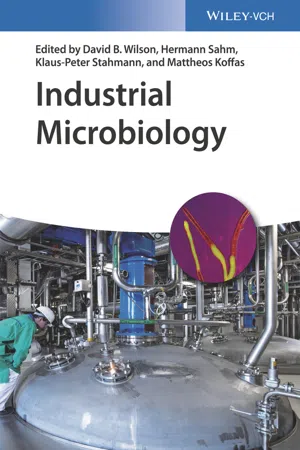
Industrial Microbiology
David B. Wilson, Hermann Sahm, Klaus-Peter Stahmann, Mattheos Koffas, David B. Wilson, Hermann Sahm, Klaus-Peter Stahmann, Mattheos Koffas
- English
- ePUB (apto para móviles)
- Disponible en iOS y Android
Industrial Microbiology
David B. Wilson, Hermann Sahm, Klaus-Peter Stahmann, Mattheos Koffas, David B. Wilson, Hermann Sahm, Klaus-Peter Stahmann, Mattheos Koffas
Información del libro
Focusing on current and future uses of microbes as production organisms, this practice-oriented textbook complements traditional texts on microbiology and biotechnology.
The editors have brought together leading researchers and professionals from the entire field of industrial microbiology and together they adopt a modern approach to a well-known subject. Following a brief introduction to the technology of microbial processes, the twelve most important application areas for microbial technology are described, from crude bulk chemicals to such highly refined biomolecules as enzymes and antibodies, to the use of microbes in the leaching of minerals and for the treatment of municipal and industrial waste. In line with their application-oriented topic, the authors focus on the "translation" of basic research into industrial processes and cite numerous successful examples. The result is a first-hand account of the state of the industry and the future potential for microbes in industrial processes.
Interested students of biotechnology, bioengineering, microbiology and related disciplines will find this a highly useful and much consulted companion, while instructors can use the case studies and examples to add value to their teaching.
Preguntas frecuentes
Información
1
Historical Overview and Future Perspective
CHAPTER MENU
- 1.1 Use of Fermentation Procedures Before the Discovery of Microorganisms (Neolithic Era = New Stone Age Until 1850)
- 1.2 Investigation of Microorganisms and Beginning of Industrial Microbiology (1850 Until 1940)
- 1.3 Development of New Products and Procedures: Antibiotics and Other Biomolecules (From 1940)
- 1.4 Genetic Engineering Is Introduced into Industrial Microbiology (From Roughly 1980)
- 1.5 Future Perspectives: Synthetic Microbiology
1.1 Use of Fermentation Procedures Before the Discovery of Microorganisms (Neolithic Era = New Stone Age Until 1850)
| Period/year | Procedures/products/discoveries |
| Prior to 4000 BC | Finds from Mesopotamia and from regions south of the Alps prove that flatbread was prepared from a grain pulp and then baked. It is likely that yeast dough is already unknowingly used, as it results in lighter, more flavorful bread. |
| From 4000 BC | The first sources show that the Sumerians in Mesopotamia and shortly thereafter the Egyptians, use grain pulp for beer production and sugary fruit juices for wine production. |
| From 3000 BC | In Mesopotamia and Egypt, sour dough bread and sour milk products (cheese) are produced. Vinegar is used as a preservative. |
| From 2000 BC | In Asia (China, Japan), soybeans are fermented with the help of fungi and bacteria (soy sauce) and rice wine is produced. In Egypt, beer brewing is “refined.” Babylon's King Hammurabi (1728–1686 BC) issues strict beer laws in the “Code of Hammurabi.” |
| From 1300 | Saltpeter production: throughout Europe, excrements were converted to potassium nitrate needed for gunpowder. It was unknown that microorganisms were the catalysts. |
| Around 1680 | Van Leeuwenhoek discovers and describes bacteria and yeasts by use of self‐prepared simple microscopes. |
| 1789 | Lavoisier identifies the products of alcoholic fermentation. |
| 1837/1838 | Cagniard‐Latour, Schwann, and Kützing attribute alcoholic fermentation to living yeasts, which divide themselves by means of budding. |